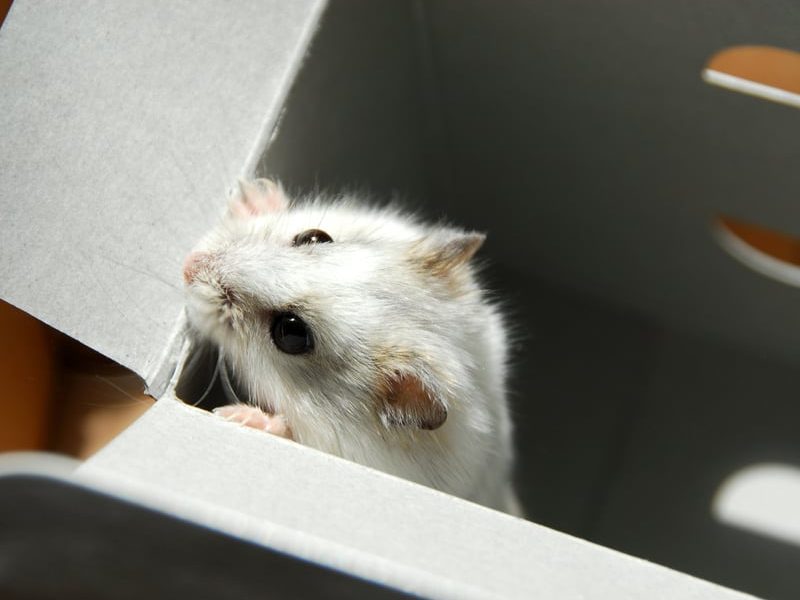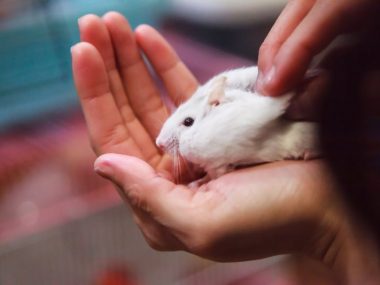Are you thinking about getting a hamster? Well, there are some fun hamster facts that you should know before bringing your new pet home. Hamsters are fascinating little creatures, and there’s always more to learn about them.
Here are 8 hamster facts every new pet owner should know:
- Hamsters are nocturnal.
- Hamsters like to hide in small places.
- Hamsters need a lot of body movement and exercise.
- Hamsters can be litter trained.
- It’s best to keep only one hamster per cage.
- Hamsters can overheat quickly.
- Overfeeding your hamster can lead to health problems.
- It’s crucial to feed your hamster a balanced diet.
If you want to learn some cool hamster facts and become a more educated pet owner, you’ve come to the right place! I’ll tell you some of the most important things to know as a hamster parent and share some interesting information about these fuzzy little rodents.
Table of Contents
1. Hamsters Are Nocturnal
Hamsters are most active at night. That means they will likely be less active during the day, so it’s essential to adjust your expectations accordingly.
For example, if you’re looking for a pet that will be playful and interactive throughout the day, hamsters may not be the best choice. However, if you’re prepared to give your hamster some space and let them run around at night, they can make excellent companions.
Hamsters are generally very friendly and love contact. However, they tend to nip, so it’s crucial always to handle them with caution, as shown in this video:
If you want to handle your hamster, start by petting them on their back or head, and if they start to get agitated, put them down immediately.
Above all, remember that hamsters are unique creatures and will not behave like other pets. Be patient with them and enjoy getting to know their personalities. With a little bit of time and effort, you’ll have a furry friend for life.
2. Hamsters Like To Hide in Small Places
Hamsters like to find small, dark places where they can curl up and feel safe. If your hamster feels threatened or scared, it may hide for hours at a time.
If you want to make sure your hamster is happy and healthy, provide it with plenty of places to hide. That could be in the form of a small house or cave that you can purchase from a pet store, or it could simply be a pile of blankets or towels where your hamster can burrow.
Make sure your hamster’s hiding place is in a quiet part of your home where it will not be disturbed, and be sure to check on your hamster regularly, even if it is hiding. That way, you can be sure that it is safe and healthy.
3. Hamsters Need a Lot of Body Movement and Exercise
Hamsters are also curious creatures and love to explore their surroundings. This activity can make for some entertaining watching, but it’s important to remember that they can get into trouble if you’re not careful. So, be sure to secure any areas of your home that could potentially be hazardous to your hamsters, such as electrical cords or open trash cans.
In addition to being curious, hamsters are also very active. They can run up to 8 miles (12.87 km) per night, so make sure you have a hamster-proofed area for them to explore.
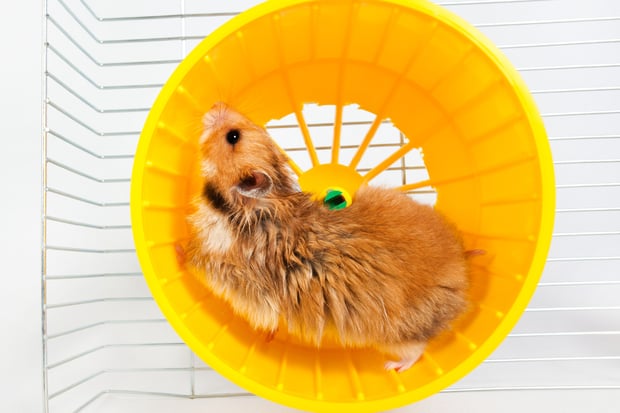
You should also encourage your pet to exercise, giving it toys and plenty of space to roam. If they don’t get enough activity, they can become overweight and develop health problems. An excellent way to exercise your hamster is to give them a wheel to play on.
You can also take them for walks outside in a safe area. Just be sure to keep an eye on them, as they may try to run away.
4. Hamsters Can Be Litter Trained
Hamsters are popular small pets that can be litter trained. That means that you can place a litter box in their cage, and they will use it to do their business.
However, hamsters also like to dig and may create a mess if not supervised. So make sure to place the litter box in an area where the hamster cannot escape and always watch them when they’re in the cage.
Additionally, clean the litter box regularly to avoid any unpleasant smells. If you’re looking for a fun and easy-to-care-for pet, a hamster may be the right choice for you. Just be sure to learn about their needs and quirks before bringing one home so that you can provide them with the best possible care.
Hamsters can make excellent pets, but there are a few things every new pet owner should know before bringing one home.
For example, did you know female hamsters can get pregnant as young as four weeks old? So, if you’re thinking of adding more than one hamster to your home, be sure to keep an eye on them and make sure they don’t mate.
5. It’s Best To Keep Only One Hamster per Cage
Hamsters don’t live in groups in the wild. Instead, they usually live alone, and they can be pretty protective of their territory. Males are especially protective, and they will fight with other hamsters.
So, when you get a pet hamster, it’s best to limit yourself to only one per enclosure. That will help to avoid any injuries or fatalities.
If you have more than one hamster in the same cage, make sure to provide plenty of space and toys for them to play with so they don’t get bored and start fighting.
Hamsters are very active animals and love to play, so make sure to provide them with plenty of toys and space to run around. Male hamsters also need a lot of attention, so spend time playing with them every day to help keep them happy and healthy.
6. Hamsters Can Overheat Quickly
Hamsters are nocturnal since they live in deserts in the wild, and they only leave their burrows when the weather is at its coolest. Although keeping a hamster in captivity usually means that it won’t get too warm, it’s always best to monitor the temperature around your pet’s enclosure.
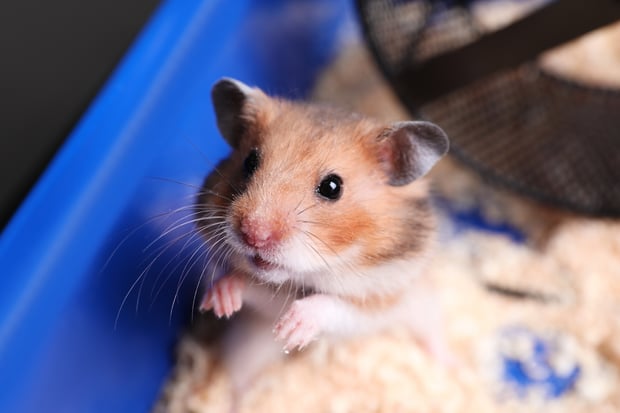
Because hamsters usually avoid warm weather, you’ll need to keep in mind that hamsters can overheat quickly. In warm weather or an overly warm environment, they will become uncomfortable and sick. So, make sure to provide your hamster with a calm and comfortable place to live with plenty of shady spots to rest.
7. Overfeeding Your Hamster Can Lead to Health Problems
It is important to remember not to overfeed your hamster. If they overeat, hamsters can develop health problems like obesity or liver disease. A healthy diet for a hamster includes a variety of fresh fruits and vegetables and a small number of high-quality pellets.
Ensure always to provide fresh water, and keep a close eye on your hamster’s food intake to confirm they’re not overeating. Another vital fact to remember is that they are still wild animals, and you should treat them respectfully. Always supervise children when interacting with a hamster, and never leave them alone together.
8. It’s Crucial To Feed Your Hamster a Balanced Diet
Hamsters are tiny rodents that can make great pets. They are active and playful and love to explore their surroundings. However, as with any pet, it is crucial to know how to take care of them properly to ensure their health and well-being.
One of the most important things you need to do when caring for a hamster is to make sure they have a balanced diet. Hamsters need plenty of fresh fruits and vegetables and good quality rodent food.
You should also avoid giving them too many treats, as this can lead to weight problems and other health issues.
Frequently Asked Questions About Hamsters
Below are some of the most common questions and fun facts about how to give your new pet hamster the care they need. This information will be helpful for new hamster owners and those who may be considering getting a hamster as a pet.
How Smart is a Hamster?
Hamsters haven’t gained a reputation as “smart” pets, but they are pretty intelligent.
Hamsters are moderately intelligent animals. They can learn simple tasks, like getting out of a cage, and you can train them to complete tasks for you. Training a hamster is an excellent way to offer it more exercise while also ensuring that you build a relationship with your pet.
So, as you interact with your pet, you may notice that it learns new behaviors quickly. If you work hard enough and use incentives like treats, you can even teach your hamster to navigate obstacle courses, follow commands, and come when you call it!
Do Hamsters Know Their Owners?
When you get a new pet hamster, it might seem like it doesn’t like you. However, hamsters are not naturally trusting pets, but once you teach them that you won’t hurt them, they will warm up to you quickly.
Hamsters know their owners and will typically be very friendly towards them. They may also bond with other family members who handle them, and they will develop more trust with you over time. So, the more you play with your hamster, the more it will like you.
Can Hamsters See Color?
Hamsters can see in color, but their vision is not as sharp as humans or other animals. That means they may not distinguish between specific colors, but they can see things moving around them.
So, that colorful cage you bought your hamster likely won’t look any different to your pet than a gray container.
Do Hamsters Cry?
Hamsters don’t cry the same way humans do. However, they will emit high-pitched squeaks when they are happy or excited. That is usually a good sign, and it means that the hamster is comfortable and content in its home.
So, hamsters won’t shed tears, but they usually make noises to indicate their mood.
How Often Do Hamsters Need To Be Handled?
Hamsters need to be handled for at least a few minutes 2-3 times per week. It would be best only to hold your hamster when it is calm and relaxed. If you handle them too often, they may become stressed or intimidated.
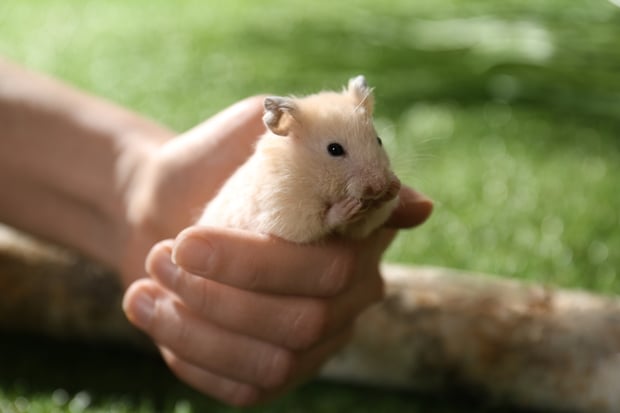
Handing your hamster is how you build trust with it, so be sure not to neglect your pet.
Do Hamsters Bite?
Hamsters bite when they feel threatened. Hamsters are not known to be aggressive animals, but they may bite if they feel uncomfortable. Therefore, it is essential always to be gentle when handling a hamster and never force it to do anything it doesn’t want to do.
Hamsters usually only bite their owners if you handle them aggressively or pick them up before building trust with them, so take things slowly. Start by petting your hamster and slowly work your way to holding it. If you interact with your hamster respectfully every day, it’ll be climbing up your sleeves in no time!
How Long Do Hamsters Live?
On average, hamsters in the wild live for around 2-3 years. However, domesticated hamsters can live a bit longer, depending on their health and lifestyle.
So, hamsters are short-term pets, but you should be ready to offer them care in the years to come before getting a new pet. In addition, if you take good care of your pet, you can ensure that it lives as long as possible.
Conclusion
Hamsters are small, furry creatures that can make great pets for new owners. They are active, playful, and require a minimal amount of care.
As with any new pet, do your research to learn everything you need to know before bringing home your new furry friend. Then, with these tips in mind, you’re ready to become a hamster owner. Just remember to always provide your pet with the best possible care, and they will surely bring you many years of joy.
